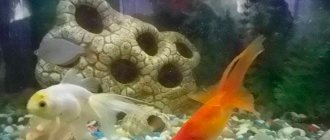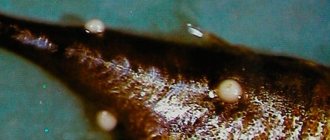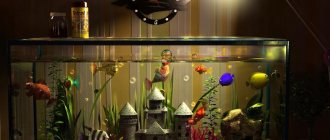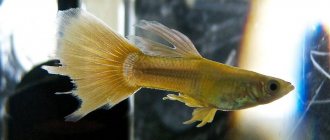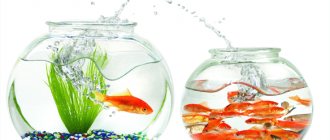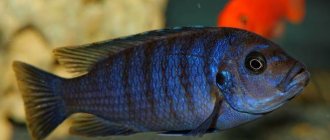This chapter examines the problems caused by fish behavior that are most commonly encountered by aquarists. The analysis of these problems is carried out in the form of questions and answers: "What to do if the fish..." We did not intend to turn this chapter into a detailed list of clearly defined guidelines, since this would require writing a separate book.
The main secret of approaching problems of this type is to determine the motives underlying this or that behavior of fish. Understanding why a fish behaves the way it does can help you find ways to resolve problems or stop unwanted behavior. Of course, many problems can be avoided from the very beginning with the help of a simple trick: before purchasing fish of a particular species, you need to find out about their likely behavior. It may be better to avoid buying them altogether if it turns out that they have destructive or simply unacceptable habits for you.
One thing is certain: fish are not to blame for behaving in accordance with instincts that have gradually formed in them over thousands or even millions of years of evolutionary development. Of course, fish cannot have the slightest intention of angering their owner. In any case, the guilty party here is the aquarist himself, who has not properly completed his task. Thus, if problems with fish behavior do arise, the aquarist has a moral responsibility for them and must resolve them in a manner that ensures the well-being of all his fish, including the “difficult” ones. Sometimes it happens that there can be only one solution - to relocate the offending fish somewhere (for example, give it to another aquarist or ask the seller to take it back). If the latter option is the only option, then the aquarist will have to come to terms with possible inconvenience and undoubted expense. Destroying an innocent creature is an unacceptable solution in this situation.
Not all of the behaviors listed below are challenging. We have included some of them in this list only because the aquarist may be concerned about deviations from normal fish behavior or simply want to understand why his fish behave the way they do.
Note: the grouping of fish behavior characteristics given in the text of this chapter corresponds to the grouping of behavioral motives given in Chapter 4.
Non-communicable diseases
Conventionally, carp diseases can be divided into infectious and non-infectious. The latter are caused precisely by habitat disturbance. Such diseases include nutritional diseases that are caused by toxic feed, disturbances in the regime of the reservoir, and atypical temperature changes.
Many diseases arise due to impaired immunity of fish, as a result of various types of stress. Non-communicable diseases are accompanied by the formation of pathogenic microflora.
Each disease has its own specifics and clinical picture. And at the same time, the manifestations of many diseases are very similar to each other. Any metabolic disorders in carp lead to disturbances in water-salt metabolism. As a result, the fish develop dropsy, bulging eyes, and ruffled scales. However, it is impossible to make a diagnosis based on appearance alone, since signs of disease can appear for other reasons. For example, from the bites of predators or during capture.
In what cases can it be treated in a community aquarium, and when is it better to remove a sick fish?
First of all, you need to determine the cause of the disease. If the culprit is a virus or parasite, then the affected fish, of course, should be quarantined. This reduces the likelihood of infection of healthy individuals. If the ailments arose due to poor care, then the cause must be eradicated in the aquarium itself.
After any illness, the community aquarium, in any case, must be thoroughly cleaned and disinfected.
Pathogenic bacteria can remain in the soil or on other surfaces, as a result of which relapse often occurs.
Are fish diseases dangerous for humans?
Diseases of carp fish can be dangerous to people. In addition to known helminthiases, fish can sometimes cause toxic infections in humans.
The main sources of the spread of the disease are uncontrolled transportation from not entirely prosperous farms to good ones. Other diseases are focal in nature. This suggests that in some regions of the country wild fish are carriers of foci of infection, living in natural reservoirs. It is almost impossible to make your farm healthy in such an area, because transportation from such a region to a healthy body of water will lead to contamination. Veterinary certificates, unfortunately, do not always reflect reality. In general, cases of diseased fish being brought into healthy bodies of water have become more frequent, which may well lead to the collapse of the entire economy. This is very dangerous for those structures that organize fishing trips.
Since there are carp diseases that are dangerous to humans, you need to be careful when choosing fish.
Reasons leading to a lack of air available for fish to breathe
There may be several factors that cause shortness of breath:
- Use to change water that has not settled properly.
- Lack of proper aeration.
- Overpopulation of the reservoir.
- Lack or excess of plants.
Learn more about each situation.
- For replacement, you can only use water that has stood for at least three days . The fact is that when the liquid enters the water supply network and passes through the pipes, it is strongly agitated. Many tiny air bubbles form in it. They are not visible to the human eye, but are dangerous for fish. If oxygen in this form enters the vessels, it will clog them. This causes suffocation. You can easily get rid of bubbles by letting the water sit. In an open container they rise to the surface and burst. Therefore, tap water that has been properly settled becomes safe.
- If the aquarium does not have an aerator or it is not powerful enough, air circulation is disrupted. As a result, air stagnation occurs.
- When the population of an artificial reservoir exceeds its supply capacity, poisoning of the aquatic environment occurs. Toxins quickly accumulate from fish waste products, excess food, and the remains of dying plants. The decomposition of organic matter occurs with the absorption of oxygen. That's why there isn't enough for everyone.
- A well-known fact about the benefits of plants is known to everyone. Flora produces oxygen even in water. At first glance, it is quite obvious that the presence of plants in an aquarium is a positive thing. But it's not that simple. If there are few of them, they cannot synthesize a sufficient amount of O2. And when there are too many of them, they take oxygen away from the fish, because they also consume it at night. That is why the plant balance must correspond to the number of fish living in the aquarium.
- Too many plants in the aquarium can lead to a lack of oxygen for the fish at night.
Infectious diseases
Let's talk about infectious fish diseases. One of them is gill necrosis. It is very dangerous and can lead to massive death of fish in a reservoir.
The disease can appear in mid- and early summer, and in the fall it usually subsides. Two-year-old carp are susceptible to this disease. However, what is the reason is still unknown. Gill disease must be distinguished from branchiomycosis. The manifestations of these diseases are very similar. There are suggestions about the bacterial or viral nature of the phenomenon. However, it has been noted that the disease is provoked by changes in the hydrochemical regime. Preventive measures are recommended in carp farms. Quarantines are imposed on the disadvantaged. The disease can cause significant damage.
Saprolegniosis
Saprolegniosis is the most common disease of carp in ponds. It is believed that it itself is secondary and forms at the site of injuries on the fish’s body. In addition, it can appear on the basis of other diseases. The causative agents are protozoan fungi, which are quite widespread.
This disease affects almost all freshwater fish. Very often it happens in carp farms due to careless handling. The fungus enters the gills, damaged tissues and destroys them. A gray coating forms on the surface of the body, similar to contaminated cotton wool.
Saprolegniosis can be prevented only by preventive measures. All activities with fish must be carried out without injury. You can use drugs such as table salt and brilliant green for prevention and medicinal purposes.
A variation of this disease is Staff's disease, which affects the nasal cavities of fish. Fungal mycelium covers the head and can penetrate into the brain. The disease usually occurs in winter during periods of severe cold.
Saprolegniosis also affects eggs in hatcheries; even salmon species are affected by the disease. Initially, the disease affects dead eggs, and then spreads to healthy ones. Brilliant green, methylene blue, and malachite green are used to treat the disease. The disease can be prevented by treating water with an ultraviolet lamp, as well as using ozonation.
Escape behavior
8. What to do if the fish is hiding
If a fish is hiding, this is a completely normal way of self-preservation for it. Some fish hide to lie in wait for prey. Therefore, it is quite natural that such fish will spend some part of their time in caves among plants or in other favorite secluded places. Some fish, especially representatives of species that care for their offspring, begin to hide during the spawning period. There are fish that hide at night. Nocturnal fish, on the contrary, usually sink to the bottom during the day. New fish recently introduced into an aquarium will often hide until they have assessed their surroundings and feel confident enough to swim out into the open.
If a fish that has not previously had the habit of hiding suddenly begins to do so, and this cannot be explained by specific spawning behavior, then the fish is probably unhealthy (see Chapter 20).
9. What to do if a fish jumps out of the water
For representatives of some species of fish, this is a characteristic behavior during escape, especially in those that constantly live near the surface of the water. In nature, they usually escape from predators in this way, but in an aquarium, such behavior is sometimes a reaction to aggression from neighbors. Some fish jump out to get food, and Arnold's copenes jump out of the water to lay their eggs.
Some small fish that live near the surface of the water, such as representatives of the wedge-bellied or carp-toothed families, have an uncanny habit of finding even the smallest holes in the lid of the aquarium and ending their days as dull, dehydrated corpses on the floor. If you have fish like this or any others in your aquarium that are known to jump out of the water. (this is usually reported in the aquarium literature), then all possible escape routes must be carefully blocked. To prevent fish from jumping out of the aquarium, you can also use floating plants. The aquarist should set himself the goal of creating an environment for the fish such that they do not have the desire to jump at all in an attempt to avoid real or imagined danger.
Jumping can also be a reaction to poisoning or certain diseases (see Chapter 20). So if any of your fish are jumping regularly, or if a fish suddenly starts jumping that hasn't done so before, it's a cause for concern. (Fish sometimes tend to leave their habitat if its parameters differ significantly from those to which they are accustomed: water temperature, its pH, etc. - Consultant's note.)
The fish can jump out of the water when threatened with a net. Since the lid of the aquarium is removed when catching fish, there is a danger that the fish may jump out of the aquarium altogether. Sick fish rarely have the strength to do this, but before catching healthy fish with a net, it is better to take a reasonable precaution - lower the water level in the aquarium. An additional partial water change will not do any harm in any case!
10. What to do if a fish gets out of the aquarium
Some fish, especially Glarias from the family of claria catfishes, as well as representatives of the families of sliders and snakeheads, are able to breathe atmospheric air and cross land areas to find another body of water if their native pond is dry. Although it is unlikely that the aquarium will ever dry out, its size and volume are certainly less than the critical minimum pond size at which these fish begin migrating in the wild. Whatever the reason, these fish may well decide to go exploring around the house if precautions are not taken. Large individuals can even move a light metal or plastic aquarium lid. Therefore, there should be no gaps between the lid and the aquarium, as well as in the lid itself, through which fish could escape. In addition, the lid must be heavy and securely fastened.
11. What to do if the fish buries itself in the ground
In this way, the fish simply hides - this is one of the possible forms of shelter. This is exactly how some loaches regularly hide. Keeping them in an aquarium without soil is an unacceptable solution. After all, depriving them of their natural shelter means acting unmercifully towards them, this can cause them nervousness and severe stress. Instead, they should be allowed to behave naturally, as in nature, and provide them with soil consisting of small particles without sharp edges.
12. What to do if the fish swims in a group
Some fish in natural conditions swim in schools for the purpose of self-defense. It is believed that the movement of a school of fish should confuse predators, and each individual fish swimming in a school has a lower statistical chance of becoming prey to a predator than if it were swimming on its own. There is an assumption that the formation of a school also plays an important role in the nutrition of such fish species. Representatives of those species of fish that usually swim in schools in nature should be kept in groups in the aquarium to prevent nervousness and stress.
There are fish that form schools not for self-defense, but because it is more convenient for them to feed, and sometimes fish of not one species, but several, gather in such schools - for example, for the purpose of exploiting an unusually rich food source. Some fish form groups during spawning, even if they normally swim alone.
Behavior associated with spawning
13. What to do if a fish “kisses” another fish
This behavior is commonly seen in cichlids, kissing gourami Helostoma temminckii, and also in some gobies. This is not a gesture of love at all, but a test of strength. Males (and sometimes female cichlids) sort things out in this way during disputes over territory or with potential spawning partners. Flirting cichlid couples also sometimes fight in this way. It is believed that they test each other’s strength and, on the basis of this, decide whether such a partner is suitable for them or not, whether he is capable of protecting the offspring and whether he will not run away when danger threatens.
You need to try not to let the “kissing” couple out of sight in order to have time to prevent a fight.
14. What to do if the fish does not allow other fish to approach a certain part of the aquarium
This usually means that the fish (or fishes) are protecting a spawning area or eggs and fry. This can cause huge problems if the aquarium is not large enough to provide the space needed for the fish (usually cichlids) while still having room for the rest of the aquarium population. In such circumstances, it often happens that such behavior greatly disturbs other fish, in addition, in skirmishes they can be injured or even killed. It is better to immediately divide the aquarium into two parts using a partition, and as soon as circumstances allow, use a larger aquarium or transfer the fish to a separate aquarium during spawning (see Chapter 8).
15. What to do if a fish attacks members of the opposite sex
Such attacks can have serious consequences, as the victim may become extremely stressed, injured or killed. The root of this problem is limited space, even if the aquarium is large enough. Under natural conditions, a fish that has become a victim of such an attack would simply swim away, but in an aquarium it will not be able to hide to a place where it would be out of sight and beyond the reach of the aggressor.
The solution to this problem depends on what species the fish is, its behavior during spawning, and the size of the aquarium. In the literature devoted to aquarium husbandry and descriptions of different species and families of aquarium fish, advice is given for each type of fish separately. As a short-term solution, you can separate the fish from its prey using a partition, or place one of the two fish in another tank.
Below are some possible scenarios when such attacks occur.
- First of all, determine whether one fish is actually attacking another - maybe it is just courting it. In some species of fish, such courtship can look, and indeed be, quite rude. Here's a good indicator: pay attention to whether the "attacked" fish stays in place (that is, whether it is interested in courtship) or tries to hide. In some species of fish (usually representatives of "non-territorial" species), pursuit is usually an integral part of the courtship ritual.
- If the fish being cared for is not ready to spawn, it may take flight or show interest at first but then escape. If there is not enough space in the aquarium for her to hide, such courtship may well turn into annoying pestering. Particularly serious problems can arise for those fish whose spawning does not take place seasonally, but all year round. The fact is that the male (usually he is the aggressor) is always ready for spawning, but the female is ready only when she is ripe (that is, her abdomen is filled with ripe eggs). Under natural conditions, she will not approach the male at all until she is ready to spawn, but within the confines of the aquarium she simply has no choice. However, her presence will be a signal to the male that she is ready to reproduce.
- Sometimes the male may wish to continue spawning after the female has laid all her available eggs.
- In some fish that care for their offspring, only one of the parents protects the eggs (for example, in gourami). In such fish, the parent who guards the eggs begins to pursue the second parent soon after spawning.
- Male cichlids sometimes attack females while caring for their offspring in a situation where a pair of cichlids is placed in a separate aquarium. It is believed that this happens because the male experiences a very strong instinctive need to defend the spawning territory and the female in this case is the only fish for him that he can attack. This problem can be resolved if the aquarium is large enough. Then you can divide the container using a transparent partition and place a “target fish” in the resulting compartment so that it distracts the male’s attention. The “target fish” must have enough space and the necessary aquarium decorations (for example, a place where it could hide). In addition, under no circumstances should she have any actual contact with the spawning pair.
- Males of viviparous fish often literally harass females who have just given birth to fry, and this can bring an already weakened individual to complete exhaustion and even lead to its death. Therefore, a prudent precaution is to isolate the female after giving birth for rest.
16. What to do if the fish does not participate in spawning
Such a situation, which caused great disappointment among future fish farmers, can have many reasons. The most common are the following:
- All fish can be the same sex.
- The fish have not yet reached sexual maturity.
- The fish are too old.
- Pisces are sterile.
- These fish may spawn seasonally.
- The oocytes (eggs) in the ovaries of females have not matured due to improper nutrition (see Chapter 7) or inappropriate water parameters - chemical composition or quality (see Chapter 10).
- Fish require a special “trigger” (one or more) to stimulate spawning; in this case, it is necessary to simulate natural conditions corresponding to the beginning of the spawning season.
- There is no substrate suitable for spawning (that is, the surface on which fish lay their eggs). Fish that naturally lay their eggs on plant leaves will not lay their eggs on stones, just as fish that lay their eggs on stones will not lay their eggs on plant leaves. (This is too categorical a statement. In aquarium practice, there is also a more flexible approach of manufacturers to the type of substrate. - Consultant's note.)
- Territorial fish do not have the opportunity to allocate a spawning territory for themselves (there are too many other fish in the aquarium, other fish dominate).
- Inappropriate water chemistry (see Chapter 10).
- Inappropriate lighting (see Chapter 12). Too little lighting usually leads to underdevelopment of the gonads (sex glands) due to insufficient stimulation of the pituitary gland.
- Fish can become stressed for a variety of reasons: poor water quality, aggression from tankmates, an unsuitable environment, and even the aquarist constantly hanging around the tank trying to get them to spawn!
17. What to expect if a fish spawns with a member of another species
This phenomenon is called hybridization and can occur when fish of closely related species are kept together.
- If there is only one individual of a given species, it may spawn with representatives of related species.
- If species are closely related, then even if individuals of both sexes of each species are present, they can still spontaneously interbreed with each other if there are no limiting factors - for example, the geographical distance of the species from each other - in natural conditions that prevent them from interbreeding.
- If a male of the desired species is unable to drive off one or more competing males of other species, then another male may fertilize the eggs.
In any circumstances, the only prudent course is to prevent the very possibility of interbreeding. If unwanted hybridization does occur, the eggs or fry should be destroyed and measures should be taken to avoid similar situations in the future (that is, the fish in question must be separated from each other).
18. What to do if a fish eats its eggs or fry
This is a fairly common problem, and it is even more frustrating for the aquarist than if the fish does not spawn at all. There are a number of possible reasons for this phenomenon:
- Many fish do not care for their offspring, and although they have strong urges to reproduce, they do not recognize their eggs and fry and mistake them for ordinary food. In such cases, it is necessary to rescue eggs or fry from their parents in order to raise them (see Chapter 8). True, some fry manage to survive even if left in the care of their parents and neighbors in the aquarium, but only if the aquarium has a sufficient number of plants that can serve as shelter, or secluded corners between stones and in crevices.
- Fish, which usually care for their offspring, may eat their eggs if they remain unfertilized. This can happen for the following reasons: the male is too young or, conversely, too old and is not able to produce milk; the male is sterile; there is no male at all; the water is unsuitable in chemical composition or quality. (Fish of some species - discus, angelfish, etc. - can imitate spawning, in which only females participate. Eggs are deposited, but, naturally, are not fertilized. - Consultant's note.)
- Young pairs of fish from caring species need some trial runs before they get it right.
- Fish of caring species may eat their eggs or fry if they are worried or stressed. Hatching and raising fry from the eggs requires a significant investment of time and energy, so if success seems unlikely, a prudent solution is to reuse the valuable protein and eat the eggs. After all, this is still better than letting it go to waste or giving it to other fish to eat. Then, when conditions become more favorable, you can try again. Therefore, if an aquarist comes up with the idea of lighting above a shelter with eggs or moving aquarium decorations to look at the laid eggs, he has only himself to blame if, under such circumstances, the clutch is eaten.
- There is growing evidence that fish learn to care for their young, and that in some fish species this instinct is learned rather than hereditary. Therefore, the fry, who for some reason grew up away from their parents, will not take care of their eggs and fry, but will eat them. The most famous example is the angelfish Pterophillum scalare. Almost ever since these fish were first kept in aquariums, the incubation of their eggs and the raising of fry have been done artificially.
- Sometimes parent fish are unfairly blamed for things that their tankmates are actually guilty of. The main villains are usually nocturnal catfish. They often arrange a midnight feast at the expense of their parent fish, which are usually active only during the daytime.
Carp diseases and their treatment for rubella
Rubella is one of the most dangerous diseases of carp and carp. In addition, rubella can affect tench, crucian carp, and grass carp. This is a highly contagious disease, the source of which is still unknown. Some experts believe that it is caused by bacteria, while others believe that it is caused by viruses. Strictly speaking, the term “rubella” refers to a number of diseases with similar symptoms. All of them are caused by different bacteria and viruses.
Rubella usually occurs in the spring or early summer. Sometimes there are surges in winter. Two-year-old and three-year-old individuals are susceptible to the disease. With an unfavorable course of the disease, bulging eyes, ruffled scales, and dropsy are noted. Ulcers may form. Chronic rubella is typical in the second half of summer with the formation of ulcers on the fins. However, only a knowledgeable specialist can make a correct diagnosis through a comprehensive study.
Such carp diseases are treated with the following drugs: tetracycline, chloramphenicol, biomycin. Currently, the use of probiotics has become common practice. Treatment is prescribed by a special doctor, taking into account the characteristics of each body of water. Improper use of antibiotics can only cause harm.
To improve the health of the economy, there is one excellent method that gives reliable results. The ponds are drained and treated with special products, and the fish are disposed of or sold.
Inflammation of the swim bladder
When discussing carp diseases (photos are given in the article), it is necessary to mention inflammation of the swim bladder. The exact cause of the phenomenon is not clear. The main point of view is viral etiology. The infection is transmitted through direct contact between fish, but transmission through soil and water cannot be ruled out.
Carp and carp are susceptible to the disease. The disease affects the walls of the swim bladder, affecting other organs. Even massive fish kills are possible. Over time, the fish become immune to this disease, and it subsides. But this option is only possible if quarantine is observed.
Koi carp
Koi were bred in Japan through selective breeding. Such fish are poorly resistant to various diseases. Koi often live in completely unsuitable places, such as carp lakes. Such reservoirs, as a rule, have a depth of up to sixty centimeters. This is not enough for koi; they need a depth of at least 120 centimeters. In addition, it is important for them what quality the water is around. If a body of water is overpopulated, then there are more pathogenic bacteria there, which means they will find their target faster.
All negative factors cause stress in fish, which lowers immunity. And then the fish get sick faster. Diseases of koi carp are the same as those of other members of the family.
Signs of oxygen starvation
There are species of fish that live in the upper layers of water. They constantly stay as close to the surface as possible, but at the same time behave calmly and measuredly. This is fine. But if the inhabitants of the middle and bottom levels rise to the surface, move jerkily and breathe heavily, intermittently, trying to get oxygen from the air, then trouble has occurred. The fish suffocated. They clearly do not have enough air, which they should get in the water.
From lack comes suffocation - asphyxia. As a result of the fact that a sufficient amount of air does not enter the body, the functioning of all organs occurs. If the anomaly drags on, the fish will die.
- If a fish floats on the surface of the water with its mouth open, it means it lacks oxygen.
Parasitic diseases of carp and their treatment
The most common disease encountered when breeding carp is ichthyophthyriosis. In addition, trichodinosis, apiosomiasis, caviosis, costiosis, and phylometroidosis are common.
To effectively treat them, you need a correct diagnosis, then, in principle, you can cope with the disease.
Ichthyophthiriasis is a dangerous disease that can cause mass death of fish. The cause is a small parasite that is resistant to many antibiotics. It develops under the skin of the fish, which becomes lethargic and a whitish rash is visible on their body. Treatment is carried out only under the guidance of a specialist. A preventive measure is to prevent foreign fish from entering water bodies.
Instead of an afterword
As we can see, carp are susceptible to many different diseases, some of which are dangerous to humans and some that are not. Be that as it may, when purchasing fish, especially in markets, be attentive to its appearance. Although external well-being does not always reflect the real state. If you have any suspicions when cooking at home or you find parasites, it is better not to eat such fish, since you yourself will not determine the degree of its danger; this requires a specialist and clinical examinations.
Important Takeaways
Based on the above materials, it is clear that carp have simply phenomenally developed sensory organs (hearing, vision, taste, smell), which allow them to survive even under the most difficult circumstances. It is especially important to understand that carp are mega sensitive to both noise and vibration. That is why, if before fishing you hammered in tent pegs with a sledgehammer, then do not be surprised: there is no bite for a long time (or the fishing “failed” completely). Remember that water enhances sound properties many times over. Even small sounds in coastal areas (when amplified) can travel long distances.
Other materials from the series “educational information about carp”:
- Features of seasonal behavior (part 2)
- Eating behavior (part 3)
- Biori (part 4)
Similar articles:
- Carp vision - WHAT and HOW does it see in the water? (Simon Scott)
Publication author
offline 1 year

